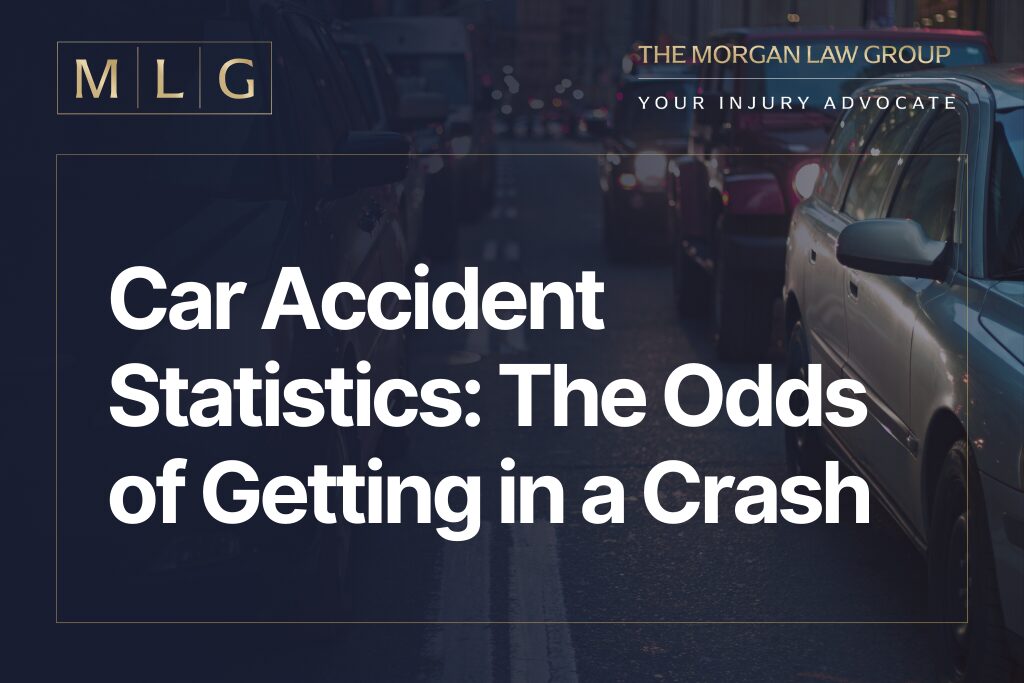The odds of getting into car accidents are shaped by multiple elements, such as driving habits, road conditions, and state regulations. With millions of vehicles on the roads, the chances of getting into a car accident remain a consistent possibility every year. These possibilities can rise or fall depending on factors like urban congestion, the presence of inexperienced drivers, and weather conditions.
- High Traffic Volume: Major highways in busy states tend to record more collisions due to the sheer volume of cars on the road.
- Changing Safety Measures: Ongoing improvements in automotive technology, such as automatic emergency braking, offer promise for reducing future crash rates. However, driver vigilance is still paramount to lowering the odds of getting into car accidents.
When car crashes do occur, having a reliable car accident attorney can make a crucial difference. Our commitment at The Morgan Law Group is to help individuals regain stability during difficult times.
States with the Highest Car Accident Rates
Road safety remains a constant concern anywhere across the nation. Some locations, however, see a higher volume of collisions than others, often because of various environmental, demographic, and legislative factors: Mississippi, Wyoming, Arkansas, South Carolina, and Montana – five states known for elevated crash statistics – and the conditions that contribute to these patterns.
1. Mississippi
Mississippi frequently appears on data lists for heightened car accident rates. According to safety reports, poor road infrastructure and limited public transportation mean residents rely heavily on personal vehicles. High reliance on rural highways, where speed limits and long stretches of open road can encourage riskier driving behaviors, also plays a role.
2. Wyoming
Wyoming features expansive rural roads, harsh winters, and a relatively small population scattered across large distances. These attributes create unique hazards, including animal crossings and limited lighting on remote highways.
3. Arkansas
Arkansas experiences higher crash counts for a range of reasons, including busy interstates and rural roads connecting smaller towns. Populations in suburban and rural zones often rely on personal vehicles, making it common to drive many miles daily.
4. South Carolina
South Carolina’s tourism industry, coastal highways, and busy metropolitan corridors contribute to increased traffic congestion. More drivers on the road raise the likelihood of collisions, especially in popular vacation spots.
5. Montana
While it may seem counterintuitive that less traffic can lead to high crash rates, vast stretches of undeveloped terrain and inclement weather make for treacherous drives in Montana
Read about the most dangeorous states in the United States.
Who Is Most Likely to Get into a Car Crash?
Although any driver on the road can face hazards, certain groups tend to encounter increased dangers, often due to inexperience, impaired judgment, or other behavioral factors.
Teenage Drivers and Inexperience
Teenagers are often at the top of the list for increased collision likelihood. The Eunice Kennedy Shriver National Institute of Child Health and Human Development (NICHD) identifies limited behind-the-wheel practice and the tendency to engage in distracting activities – such as texting and talking with friends – as key risk factors. Teen drivers may also underestimate speed limits or fail to wear seat belts consistently, adding to the odds of crashes.
Older Adults
Although most older adults drive with caution, certain health concerns – slower reaction times, vision limitations, and possible medication side effects – can increase the probability of incidents. Periodic vision tests, physical checkups, and honest self-assessments of driving abilities are often advisable for this group.
Factors Influencing the Chances of Getting into Car Accidents
Road safety depends on more than just obeying traffic signals. Multiple elements – ranging from how a driver behaves behind the wheel to environmental conditions – can increase the odds of getting into car accidents.
Driving Behaviors
- Distracted Driving: Texting or using a smartphone while on the road elevates the odds of getting into car accidents significantly.
- Impaired Driving: Alcohol and drug use remain leading causes of fatal crashes.
- Speeding and Aggressive Driving: Exceeding speed limits and following other cars too closely often contributes to avoidable collisions.
Vehicle Conditions
- Poor Maintenance: Worn brake pads, underinflated tires, or faulty headlights can compromise a driver’s ability to control their vehicle, thus increasing the chances of getting into a car accident.
- Safety Features: Modern cars offer crash avoidance systems. Regular upkeep of such features contributes to reducing collisions.
Road and Environmental Hazards
- Weather: Rain, snow, and ice can cause slippery conditions. Even in sunny states like Florida and Texas, sudden rainstorms can create treacherous roads.
- Infrastructure: Uneven pavement, low visibility areas, and congested intersections raise the odds of getting into car accidents.
Recognizing these underlying factors helps individuals make informed decisions that may lower the chances of getting into a car accident.
Different Types of Car Crashes
While every collision is unique, certain types of crashes occur more frequently than others.
These include:
- Head-On Collisions: Head-on collisions can be particularly dangerous. These crashes frequently take place on two-lane roads when one vehicle drifts out of its lane, often due to drowsiness or impaired driving.
- Side-Impact Crashes: These occur when one car collides with the side of another vehicle, typically at intersections. The lack of a substantial buffer on the sides of a vehicle means injuries can be severe.
- Sideswipe Accidents: Drivers on multi-lane roads who fail to check blind spots or signal properly risk sideswiping adjacent cars. Although these collisions can be minor, they may escalate if one or both drivers overcorrect.
- Rollover Crashes: High-profile vehicles such as SUVs or trucks have a greater tendency to tip over, especially during high-speed maneuvers or on curvy roads. Rollovers can cause serious injuries to occupants.
- Multi-Vehicle Pileups: Chain-reaction collisions involve multiple vehicles and often occur in heavy traffic or during severe weather when drivers cannot slow in time. Visibility issues or distracted driving can compound the problem.
Whether it is a rear-end collision or a rollover, the odds of getting into car accidents often hinge on driver conduct and environmental factors.
High-Risk Seasons for Car Accidents
While car accidents can happen at any time, certain seasons see notable spikes in collision rates due to changes in weather, holiday travel, and other factors.
- Winter Months: Snow, ice, and freezing rain create slick roadways, reducing tire traction and prolonging stopping distances. In states like Colorado or those with mountainous regions, driving becomes particularly hazardous.
- Summer Travel Season: Roadways often host higher traffic volumes from family vacations or holiday gatherings. This congestion, coupled with heat-related vehicle failures like overheating engines, can affect the odds of getting into car accidents.
- Holiday Periods: Celebrations during the Fourth of July, Thanksgiving, or New Year’s Eve often correlate with more impaired driving incidents, making certain long weekends riskier than others.
Drivers can enhance safety by preparing vehicles for seasonal changes – winter tires, routine fluid checks, and ensuring functional air conditioning in hotter months – to lessen the likelihood of collisions.
Vehicles with High Car Accident Rates
Not all vehicles perform equally on U.S. roads. Some models show a higher incidence of crashes or more severe outcomes for occupants. Factors affecting a car’s collision profile include engineering, driver demographics, and how well the vehicle withstands impacts. For instance, sports models often attract drivers inclined to speed or maneuver aggressively. If these vehicles lack robust safety features, crash consequences may be severe.
Reducing the Chances of Getting into a Car Crash
Although every drive comes with potential risks, several strategies can reduce the odds of getting into a car accident.
The following detail how these simple yet crucial steps can help protect both drivers and those around them.
- Stay Alert: Keep your eyes on the road, avoiding distractions like phone calls or texts.
- Maintain Safe Following Distances: Allow enough space between your car and the vehicle in front of you.
- Adhere to Speed Limits: Speeding remains a leading cause of collisions. Consistent and controlled driving can lower the odds of getting into car accidents.
- Tire Checks: Monitor tire pressure and tread to ensure proper traction.
- Brake and Engine Maintenance: Ensure brakes are fully operational. Engine misfires can lead to performance issues that hinder quick responses on the road.
- Technology Updates: Keep essential safety features in proper working order and address recall notices promptly.
- Seat Belt Use: Buckling up is one of the most effective ways to minimize injuries in car accidents.
- Proper Child Restraints: Use the right car seats and booster seats based on your child’s age, height, and weight.
By practicing defensive driving, keeping vehicles in top condition, and ensuring passengers follow basic safety measures, individuals have a far better chance of avoiding collisions.
Injured in a Car Accident – Let Us Handle Your Case
Car accidents remain an ever-present concern for drivers of every age and background. While the odds of getting into car accidents fluctuate based on numerous factors, a thorough understanding of driving behaviors, vehicle upkeep, and legal rights can lower the chances of getting into a car accident and improve your ability to seek fair compensation if a collision occurs.
Should you need to discuss your situation with a capable car accident attorney, The Morgan Law Group is ready to stand by your side. Call us at (800) 551-0554 or answer our online form to schedule your free case evaluation.

